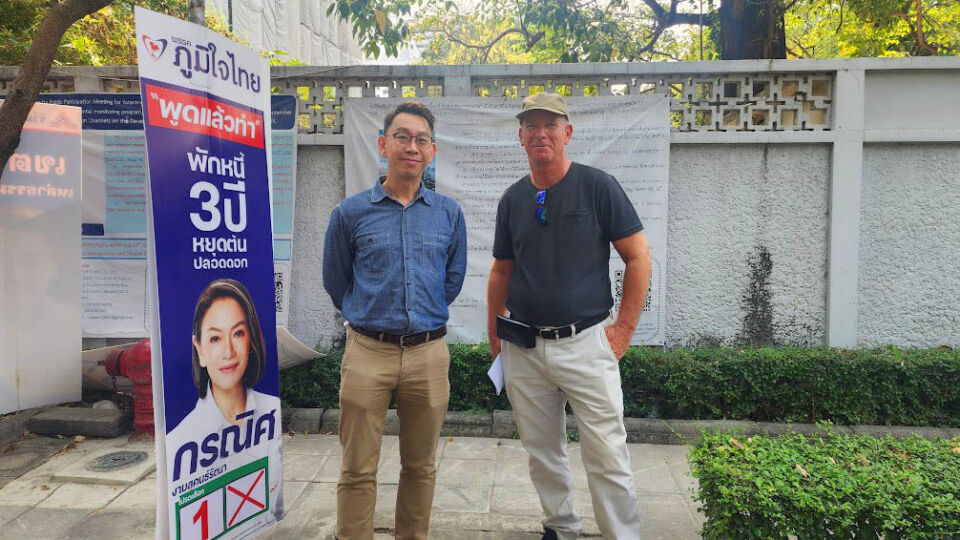A quiet conflict has been unfolding just off Sukhumvit on a leafy road bookended by two schools and lined with mid-rise residential buildings, family compounds, and a few businesses.
It’s the kind of slow-burning dispute argued across megacities in the dispassionate language of building codes and due process that belies a deep unease with expansion and development. The locations vary, but the circumstances are similar: Developers see windfall profit in knocking down low-density housing to build something larger only to run into a community’s steadfast distaste for change.
In the case of Soi Sukhumvit 53, it’s two somethings larger. One, a 70-room hotel rising seven floors. Behind it, a 37-story residential tower with 212 units. Although the project is currently on bureaucratic hold, the ultimate outcome may depend on a court’s interpretation of what constitutes a “road.”
“No Skyscrapers in Our Soi,” reads one of several banners hung in recent months around the project site.
Serious urbanistas who favor urban infill to sprawl might side with the developers. But tell that to the people who want to keep the same view from their windows without adding more traffic.
Which side usually prevails in these contests – developers or residents – is little surprise, with the answer writ large in Bangkok’s ever-expanding skyline. But this test of wills and legal interpretations is taking place in a soi inhabited by a former prime minister, the family fortress of the billionaire Red Bull Yoovidhya clan, as well as other powerful and wealthy residents.
Robert Horn is not one of them. The American musician has been a rent-paying soi resident for 28 years.
“It’s going to damage our community and destroy one of the most beautiful sois in the Sukhumvit area,” Horn said bluntly of developer GSPS Holdings’ Upper Suites Sukhumvit 53 project in a recent interview.
Probably the most active and organized dissent comes across the road from the project, where Bhuvanant Bhuvanattrai leads a group of concerned residents of the Raintree Villa condominiums. He said he’s lived in the soi for 22 years.
“New neighbors are always welcome. However, the project has to obey the law,” he said at a September 2021 public hearing, according to its minutes. Held during the pandemic, Horn and about 15 other neighbors attended to note their exceptions.
Almost a year later, roughly 50 people attended an August 2022 hearing in person or remotely, including a retired army general and district MP Koranit Ngamsukonratana, who lost her post in last month’s election.
The hearing was also attended by several members of the very, very affluent and influential Srichawla family, which owns GSPS Holdings. The family’s Fico Corp. also had reps at the meeting, as it is building a project called Town Hall Sukhumvit 49 in the eponymous soi behind the site of Upper Suites.
Fico has a role in projects across the capital. It is the domestic partner for major brands such as Domino’s Pizza as well as familiar 4- and 5-star hotels such as the Holiday Inn Bangkok, Muse, Grand Millennium Sukhumvit, and Novotel Fenix. It co-owns Soi Sukhumvit 4 sex mall Nana Plaza along with Paul Hayward’s Panthera Group.
That is to say, they’re big-time people too.
Since the hearings, the committee responsible for reviewing impacts on the environment has so far declined to approve the project, but that is not uncommon. The developers have almost four more months to resubmit their report for reconsideration.

The project’s fatal flaw, according to its opponents, is that the law forbids structures over 23 meters in height, or about eight stories.
(This is a sore point for Horn, who happens to live in a towering condo up the road called Habitat 53, which he says predated the code revisions that introduced the limitation about three decades ago.)
A walk down the soi finds that structures built since then have kept to the height limit.
The reason for the restriction is easy to understand: People burning to death. Bangkok, like many developing cities, has had some ugly fires with tragically high body counts. To avoid this, firefighters need easy access for their trucks and heavy equipment. That means sufficiently wide roads.
“The law is, if you want to build higher than eight stories, the road has to be 10 meters wide from the project site to the main road,” Horn said. “Which we believe to be Sukhumvit Road.”
Soi Sukhumvit 53 is too narrow, at least in certain stretches.
But the words used in the building code vary in different versions. One states that it is a “road” which must be 10-meters wide; elsewhere it is described as a “public way.”
The developer, whose representatives could not be reached by email or telephone for comment, favors the latter interpretation. That’s its basis for a workaround: Soi Thonglor 5. While that road is only about 9 meters at its widest, a weed-choked canal runs beside it that trickles with water and connects Soi 53 to Soi 55, aka Thonglor.
Include the canal, and that “public way” is now about 14 meters wide. Soi Thonglor 9 also has a canal and is another possibility.
The builders say that satisfies the letter of the law. The project’s detractors say it’s not in its spirit as the canal can’t be used by emergency services.
At the hearing, Bhuvanant said that moving the project forward and debating other points of contention made no sense until that fundamental question had an answer.
“The consideration of buildings of any type is a waste of time because if the building cannot go higher than 23 meters, it is not relevant to consider other issue[s].”
Both sides are trying to present evidence of court decisions that support their respective positions.
“If the developers fail to find any other cases that support their cause,” Bhu said, “at least we have one that is very solid, that a court ruled a development was illegal.”
The developers have until Oct. 1 to resubmit their environmental impact assessment report for consideration.




